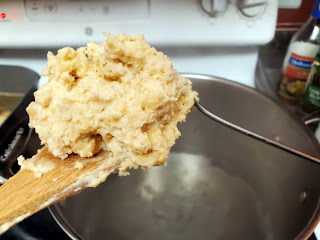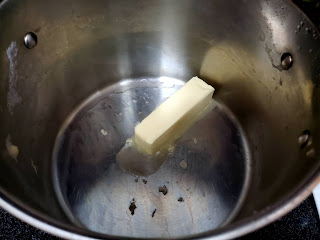If there's one thing German's know, it's good cooking. Mind you, there's nothing healthy about a heaping plate of pork schnitzel and spatzle. Between the oil for frying, and the butter for sauteing, it's all about fat, which equates to flavor.
Well, if you haven't guessed it by the title, today I'm going German with a homemade recipe of pork schnitzel and spatzle. To top it all off, I'm whipping up a delicious mustard sauce which will accompany it all perfectly.
True to most of my recipes, this isn't something you're going to throw together in a few minutes. So you're going to want to give yourself at least the morning of to start, which is what I did. This was so I could prep the pork.
Ingredients
2 Pounds Thick Pork Chops
Zest From One Lemon
Juice From Half Of One Lemon
2 Cups Flour
1 1/2 Cups Unseasoned Breadcrumbs
1 1/2 Cups Unseasoned Panko Breadcrumbs
1 Tablespoon Salt
2 Tablespoons Pepper
Five Eggs
Additional Salt And Pepper To Taste
Starting with four thick pork chops, I'm using the flat side of a meat mallet to pound out each one to about 1/4 of an inch thick. As a tip, it's incredibly helpful to fold over a piece of wax paper, and place it over top of the meat when striking it. This helps to eliminate damaging the meat. Additionally, you can put a towel under your cutting board to dampen the sound a bit.
Ignoring the rolling pin, which didn't work as I intended it to, keep flipping the meat over as you pound each side, until you have the desired thickness. The fact that this one came out looking like a Superman insignia is what we'll call a happy bonus.
For comparison, here's a side by side of the first chop I flattened, next to one I have yet to touch.
As you get done with each one, move it to a plate with a piece of wax paper on the bottom, and cover each piece with another sheet of wax paper. You'll be using these pieces a few times throughout this process, so don't thrown them away. As for the piece you're using to cover your meat while pounding it, replace as needed, as it will get damaged.
You'll need a large dish, which is big enough to hold each piece of meat flatly for this next step. I'm personally using a large casserole dish for this. In said dish, I'm combining two cups of flour with 1 tablespoon of salt, two tablespoons of pepper, and as much zest as I can get from one lemon.
Stir it up, and if you like, let it sit for about thirty minutes to release some of the zest into the flour. However, if you also like, simply move on to the next step, which is to dredge each piece of pork in the flour mixture, coating it thoroughly.
Give it a little shake when done to remove any excess flour, and place it back on its respective piece of wax paper. Repeat with each remaining piece.
Now you're going to need two large containers which can hold an entire piece of pork. For this, I rinsed out my dish holding the flour, and also grabbed a large glad plastic container. Whatever you use, like I said, you need two.
In a large bowl, add five eggs, and salt and pepper to taste. Juice half of one lemon into the egg, and whisk until fully scrambled. When finished, transfer your egg mixture to one of your large dishes. You don't want to scramble your eggs in your large dish, because the size of it will make it more difficult than utilizing a bowl.
In your second large dish, combine 1 1/2 cups unseasoned breadcrumbs, and 1 1/2 cups unseasoned panko bread crumbs. Gently shake the dish to incorporate them together.
Starting with your first piece of pork, dredge it on both sides through the egg mixture, rotating it a few times to evenly coat. Don't leave any areas of meat without egg, otherwise your breadcrumbs will not adhere to it.
Immediately transfer it to the breadcrumb mixture, and coat it thoroughly with crumbs, pressing gently to adhere them.
Transfer this back to its piece of wax paper, and repeat until finished.
Cover the top piece of pork with another piece of wax paper, and place it in the fridge to set. You want to give this at least one hour, but all day is fine if you're off to work, or something like that.
IMPORTANT: Save one cup of your breadcrumbs for later use.
When you're ready to start cooking, that's when things are going to become a bit hectic for this particular meal. Especially if you're cooking alone. Multitasking is going to be a must.
Let's start by preparing our spatzle, which I've already talked about in a prior post. Same recipe. Same concept. Smaller pieces.
Ingredients
2 Cups Flour
1 1/2 Teaspoons Salt
4 Eggs
1/2 Cup Heavy Whipping Cream
Before you even start mixing anything, start yourself a hot pot of water, seasoned with salt, to boil. You will need a fairly large one to allow your spatzle to move and breath.
Additionally, you want to start your oil for frying the pork. Once again, I'm using my trusty electric skillet to help me moderate temperatures. I'm also using vegetable oil, but you can use canola as well. I would avoid olive, corn, or any other oil that is going to add or alter the flavor.
I'm regulating my temperature at three hundred fifty degrees. I also only use enough oil to cook one side at a time. However, you could deep fry these if you really wanted to save time.
Get your first pork chop going before getting back to your spatzle. However, only add one chop at a time. There's a couple reasons for this. First, you want to make sure your pan can even accommodate two pieces of meat. Second, every time you add something to oil, it reduces the temperature. Meat shrinks as it cooks, so ideally, it's best to ultimately get two pieces in together to reduce cooking time. Each one is going to take about seven to ten minutes per side.
While the pork is getting fried up, in a large bowl combine your two cups of flour and 1 1/2 teaspoons of salt. Give it a stir to incorporate.
In a measuring cup, measure out your 1/2 cup of cream, and if you have room, go ahead and crack your four eggs into it. Then simply pour it into your flour, and get to stirring up. You can use your hand, spoon, rubber spatula, whichever you like.
By now, you're also probably flipping your pork, and have two pieces in the pan. Additionally, your water is probably boiling.
Take a heaping spoon (or handful) of your spatzle mixture, and start pinching it off in very small pieces, dropping them into the water. Be careful. Boiling water will burn you quickly. Work fast, carefully, and as far away from the steam as possible.
Once it's all in the water,give it a quick stir to spread it around the pot. This is only going to take about three minutes to cook, and when done, you want to drain it immediately into a colander, all while continuing to balance double duties with cooking pork.
Spatzle is versatile, and can be seasoned with any number of things. Today, I'm make a bread and butter sauce, and for that, I need one whole stick of butter melting over low heat. I'm using the same pot I cooked the dough in for this.
When melted, I'm adding my reserved one cup of breadcrumbs, and stirring it around to thoroughly coat it in butter. I'm going to let this get golden brown in the pot.
When it does, I'm going to add a little pepper to taste, but no salt. There is plenty in the butter and spatzle dough. Yes, I'm also still conducting double duties on cooking pork at this time, and you will too if following this recipe.
Turn the heat off, add your spatzle, and quickly stir it together. What you'll notice is that the butter mixture pretty much disappears, and things actually look a bit dry. Not to worry. Move the pot off the heat, and throw another half a stick of butter on top, and cover it with spatzle to allow it to melt on its own. Hey, I said in the first paragraph this dish wasn't healthy.
Now you're going to need a medium sized skillet, which we'll be using for our sauce.
Ingredients:
2 Tablespoons Butter
2 Tablespoons Flour
3/4 Cup Heavy Whipping Cream
1 1/4 Cup Chicken Broth
2 Tablespoons Dijon Mustard
1/4 Teaspoon Pepper
Before we jump into the sauce, let's talk about that pork real quick. You'll notice that as I'm finishing mine that I'm moving it to a large sheet pan. You'll also notice that the outer edges are a bit browner than the center. This is intentional. The reason being, I'm double frying these.
Why do we double fry? It's simple really. When you fry things for the first time, the outside gets dry, and the inside layer stays wet. However, as your food rests after the first initial frying, that moisture starts moving outward as it rests for a few minutes, which is why you can see in the photo that the top looks...Well, soggy.
Double frying drys this up, creating a crispier coating. When double frying, you want to return whatever it is you're cooking to oil for three to five minutes to reach a desirable crispness. This works just as well for breaded foods as it does for french fries, or other fried foods that you want to be extra crispy. The second frying will take place once my sauce is done, which will also serve to keep the meat hot when serving.
Okay, so now that we know, let's get back to the sauce.
In your pan, melt two tablespoons of butter.
When melted, add your flour, and use a whisk to stir it up.
Stir it periodically over medium heat, but ultimately, what you're looking for is a nutty brown color.
Give it a good whisking to incorporate everything together, and then add your chicken broth.
Add your heavy whipping cream, dijon mustard and pepper. As you can see from the photo, I had all of these in the same measuring cup.
Keep whisking, and let it come to a boil over medium heat, but then immediately reduce it to low. It will start to thicken fast, and you want it to be smooth and creamy, not thick and chunky.
Look for a consistency that coats a spoon, but still mostly runs off.
By now your butter in your spatzle is melted, so give it a good final stir. Additionally, your meat is done, and so is your sauce. Simply serve it up.
While I would have normally served up my pork simply with the lemon wedges from my other half lemon, I accidentally dropped this on the floor while cooking. As such, since I had to slice up another lemon, I also went ahead and zested it over top the meat as well. I'm glad I did, and recommend you do as well.
Even if you don't, it's all good. get you a plate, and you know what comes next. Get to digging in.
Mmm, that sauce. It's the true star of the show. It brings out the flavor in both the pork and spatzle, and all around everything just compliments each other so fantastically.
Click "HERE" to go back to the home page. For more posts related to this one, please click the labels below.

































No comments:
Post a Comment